Financial Management and Analysis: Unilever Performance Report
VerifiedAdded on 2022/12/26
|15
|4005
|47
Report
AI Summary
This financial management and analysis report provides a comprehensive overview of key financial concepts and their application. The report begins with a critical analysis of Unilever's financial performance over two years, examining liquidity, profitability, efficiency, capital structure, and stock market performance through ratio analysis. It then discusses the limitations of such analysis and offers recommendations for improvement. The report further explores investment appraisal techniques, calculating payback period, net present value (NPV), and internal rate of return (IRR) for different investment choices, along with recommendations on the preferred method. The analysis extends to shareholder rights, including calculations of theoretical ex-rights price and the impact on shareholder wealth. Additionally, the report covers market capitalization, net asset value, and valuation using the P/E ratio method. It concludes with a discussion of systematic and unsystematic risk, capital and money markets, the difference between risk and uncertainty, and the feasibility of a bank overdraft option.
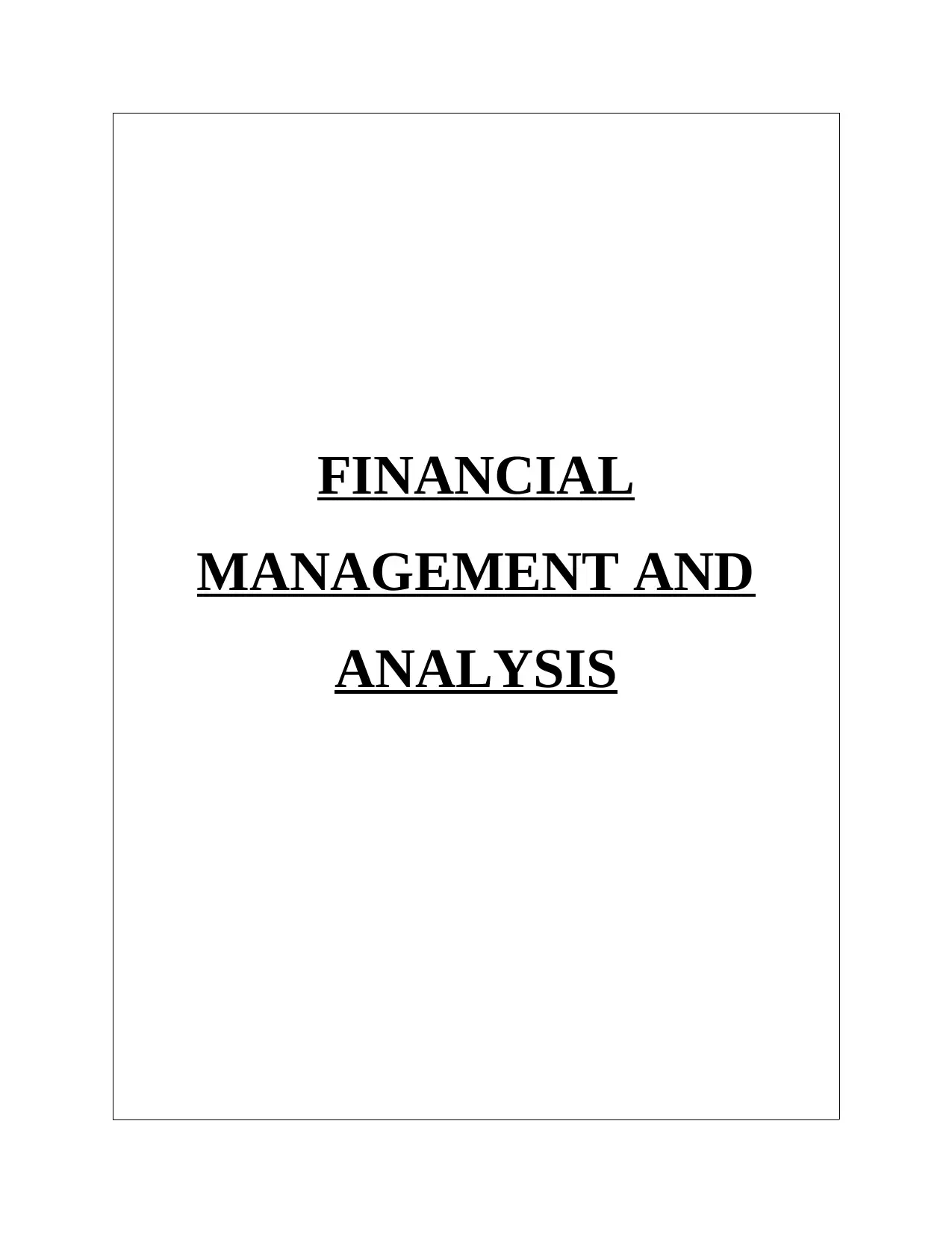
FINANCIAL
MANAGEMENT AND
ANALYSIS
MANAGEMENT AND
ANALYSIS
Paraphrase This Document
Need a fresh take? Get an instant paraphrase of this document with our AI Paraphraser
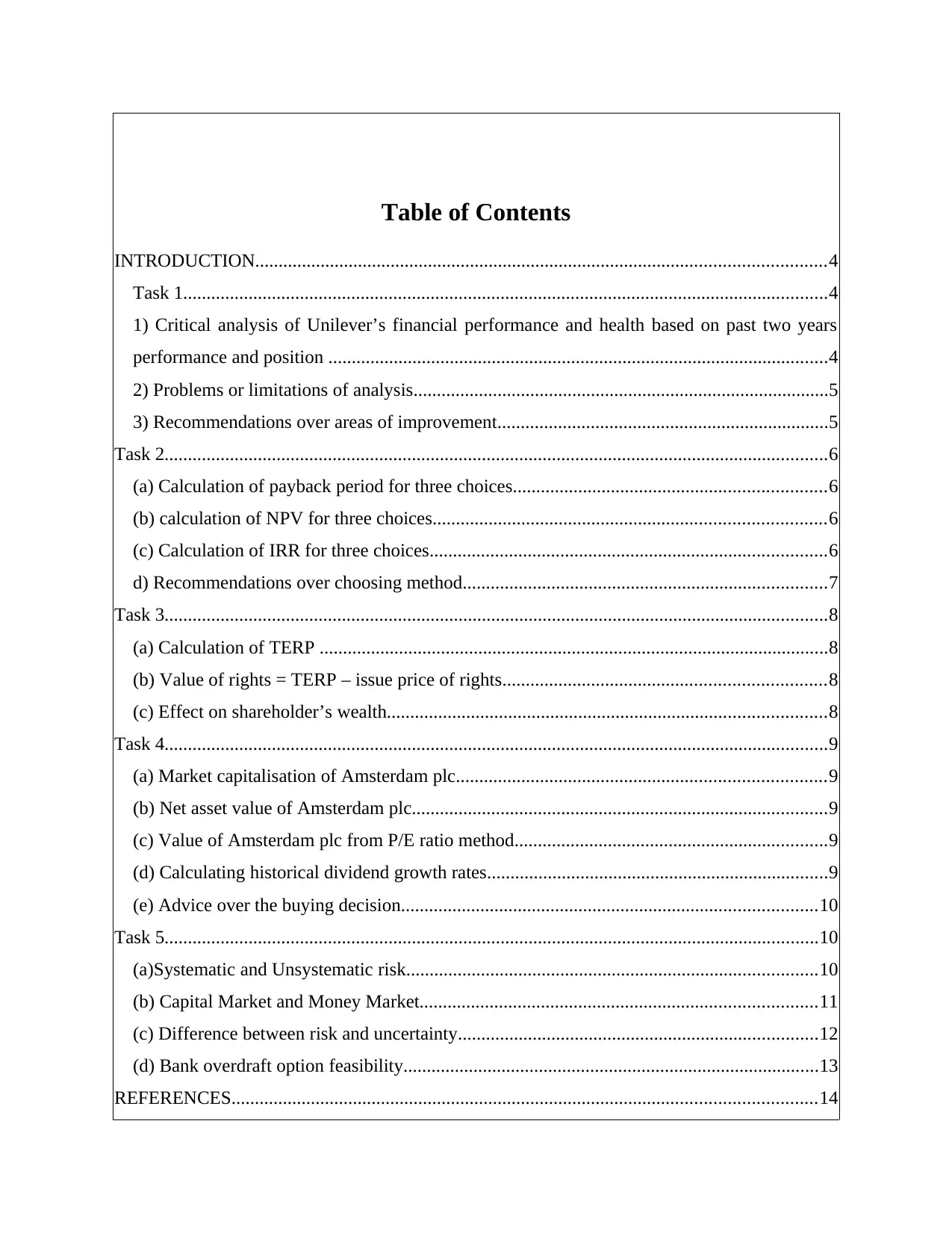
Table of Contents
INTRODUCTION..........................................................................................................................4
Task 1..........................................................................................................................................4
1) Critical analysis of Unilever’s financial performance and health based on past two years
performance and position ...........................................................................................................4
2) Problems or limitations of analysis.........................................................................................5
3) Recommendations over areas of improvement.......................................................................5
Task 2..............................................................................................................................................6
(a) Calculation of payback period for three choices...................................................................6
(b) calculation of NPV for three choices....................................................................................6
(c) Calculation of IRR for three choices.....................................................................................6
d) Recommendations over choosing method..............................................................................7
Task 3..............................................................................................................................................8
(a) Calculation of TERP .............................................................................................................8
(b) Value of rights = TERP – issue price of rights.....................................................................8
(c) Effect on shareholder’s wealth..............................................................................................8
Task 4..............................................................................................................................................9
(a) Market capitalisation of Amsterdam plc...............................................................................9
(b) Net asset value of Amsterdam plc.........................................................................................9
(c) Value of Amsterdam plc from P/E ratio method...................................................................9
(d) Calculating historical dividend growth rates.........................................................................9
(e) Advice over the buying decision.........................................................................................10
Task 5............................................................................................................................................10
(a)Systematic and Unsystematic risk........................................................................................10
(b) Capital Market and Money Market.....................................................................................11
(c) Difference between risk and uncertainty.............................................................................12
(d) Bank overdraft option feasibility.........................................................................................13
REFERENCES.............................................................................................................................14
INTRODUCTION..........................................................................................................................4
Task 1..........................................................................................................................................4
1) Critical analysis of Unilever’s financial performance and health based on past two years
performance and position ...........................................................................................................4
2) Problems or limitations of analysis.........................................................................................5
3) Recommendations over areas of improvement.......................................................................5
Task 2..............................................................................................................................................6
(a) Calculation of payback period for three choices...................................................................6
(b) calculation of NPV for three choices....................................................................................6
(c) Calculation of IRR for three choices.....................................................................................6
d) Recommendations over choosing method..............................................................................7
Task 3..............................................................................................................................................8
(a) Calculation of TERP .............................................................................................................8
(b) Value of rights = TERP – issue price of rights.....................................................................8
(c) Effect on shareholder’s wealth..............................................................................................8
Task 4..............................................................................................................................................9
(a) Market capitalisation of Amsterdam plc...............................................................................9
(b) Net asset value of Amsterdam plc.........................................................................................9
(c) Value of Amsterdam plc from P/E ratio method...................................................................9
(d) Calculating historical dividend growth rates.........................................................................9
(e) Advice over the buying decision.........................................................................................10
Task 5............................................................................................................................................10
(a)Systematic and Unsystematic risk........................................................................................10
(b) Capital Market and Money Market.....................................................................................11
(c) Difference between risk and uncertainty.............................................................................12
(d) Bank overdraft option feasibility.........................................................................................13
REFERENCES.............................................................................................................................14
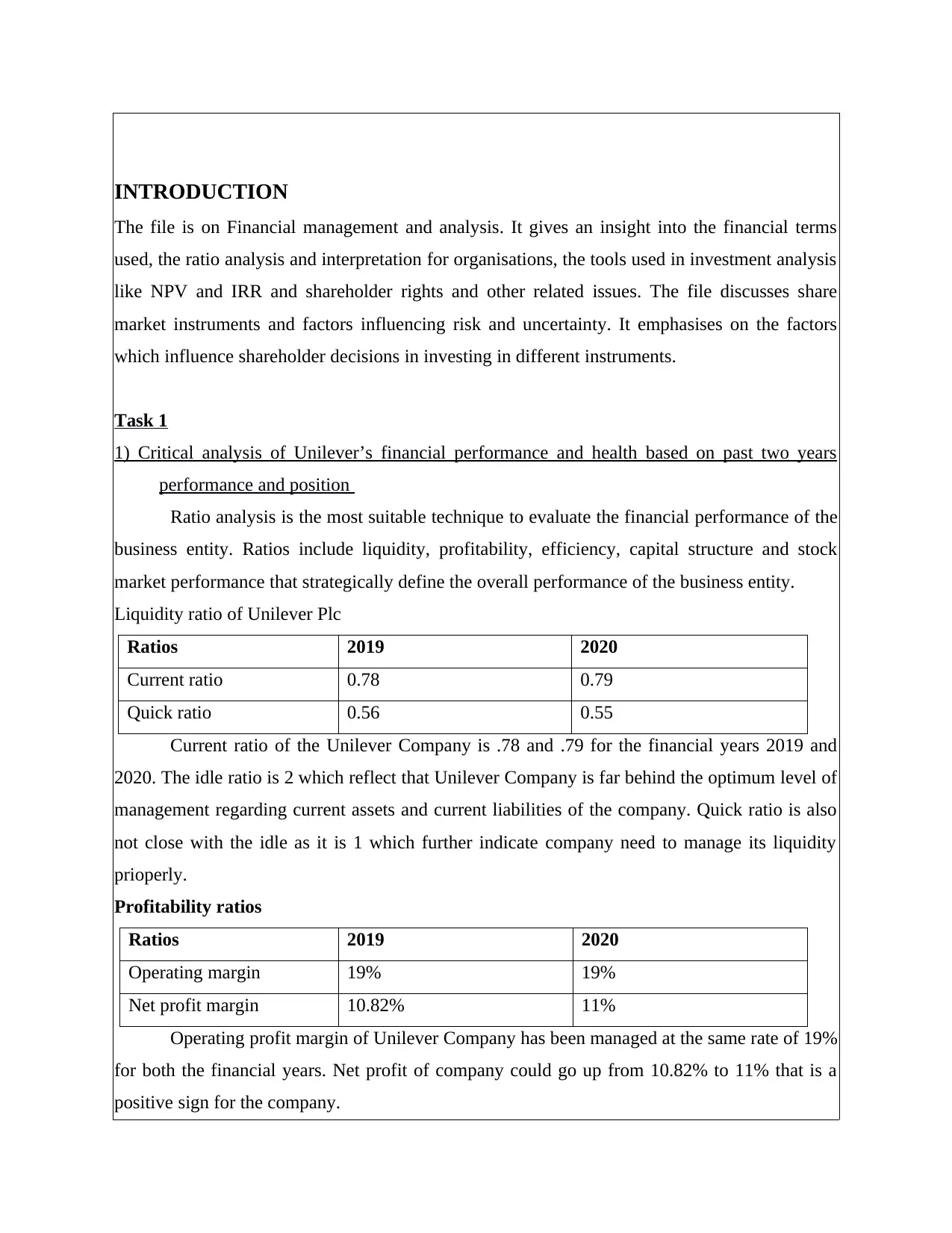
INTRODUCTION
The file is on Financial management and analysis. It gives an insight into the financial terms
used, the ratio analysis and interpretation for organisations, the tools used in investment analysis
like NPV and IRR and shareholder rights and other related issues. The file discusses share
market instruments and factors influencing risk and uncertainty. It emphasises on the factors
which influence shareholder decisions in investing in different instruments.
Task 1
1) Critical analysis of Unilever’s financial performance and health based on past two years
performance and position
Ratio analysis is the most suitable technique to evaluate the financial performance of the
business entity. Ratios include liquidity, profitability, efficiency, capital structure and stock
market performance that strategically define the overall performance of the business entity.
Liquidity ratio of Unilever Plc
Ratios 2019 2020
Current ratio 0.78 0.79
Quick ratio 0.56 0.55
Current ratio of the Unilever Company is .78 and .79 for the financial years 2019 and
2020. The idle ratio is 2 which reflect that Unilever Company is far behind the optimum level of
management regarding current assets and current liabilities of the company. Quick ratio is also
not close with the idle as it is 1 which further indicate company need to manage its liquidity
prioperly.
Profitability ratios
Ratios 2019 2020
Operating margin 19% 19%
Net profit margin 10.82% 11%
Operating profit margin of Unilever Company has been managed at the same rate of 19%
for both the financial years. Net profit of company could go up from 10.82% to 11% that is a
positive sign for the company.
The file is on Financial management and analysis. It gives an insight into the financial terms
used, the ratio analysis and interpretation for organisations, the tools used in investment analysis
like NPV and IRR and shareholder rights and other related issues. The file discusses share
market instruments and factors influencing risk and uncertainty. It emphasises on the factors
which influence shareholder decisions in investing in different instruments.
Task 1
1) Critical analysis of Unilever’s financial performance and health based on past two years
performance and position
Ratio analysis is the most suitable technique to evaluate the financial performance of the
business entity. Ratios include liquidity, profitability, efficiency, capital structure and stock
market performance that strategically define the overall performance of the business entity.
Liquidity ratio of Unilever Plc
Ratios 2019 2020
Current ratio 0.78 0.79
Quick ratio 0.56 0.55
Current ratio of the Unilever Company is .78 and .79 for the financial years 2019 and
2020. The idle ratio is 2 which reflect that Unilever Company is far behind the optimum level of
management regarding current assets and current liabilities of the company. Quick ratio is also
not close with the idle as it is 1 which further indicate company need to manage its liquidity
prioperly.
Profitability ratios
Ratios 2019 2020
Operating margin 19% 19%
Net profit margin 10.82% 11%
Operating profit margin of Unilever Company has been managed at the same rate of 19%
for both the financial years. Net profit of company could go up from 10.82% to 11% that is a
positive sign for the company.
⊘ This is a preview!⊘
Do you want full access?
Subscribe today to unlock all pages.

Trusted by 1+ million students worldwide
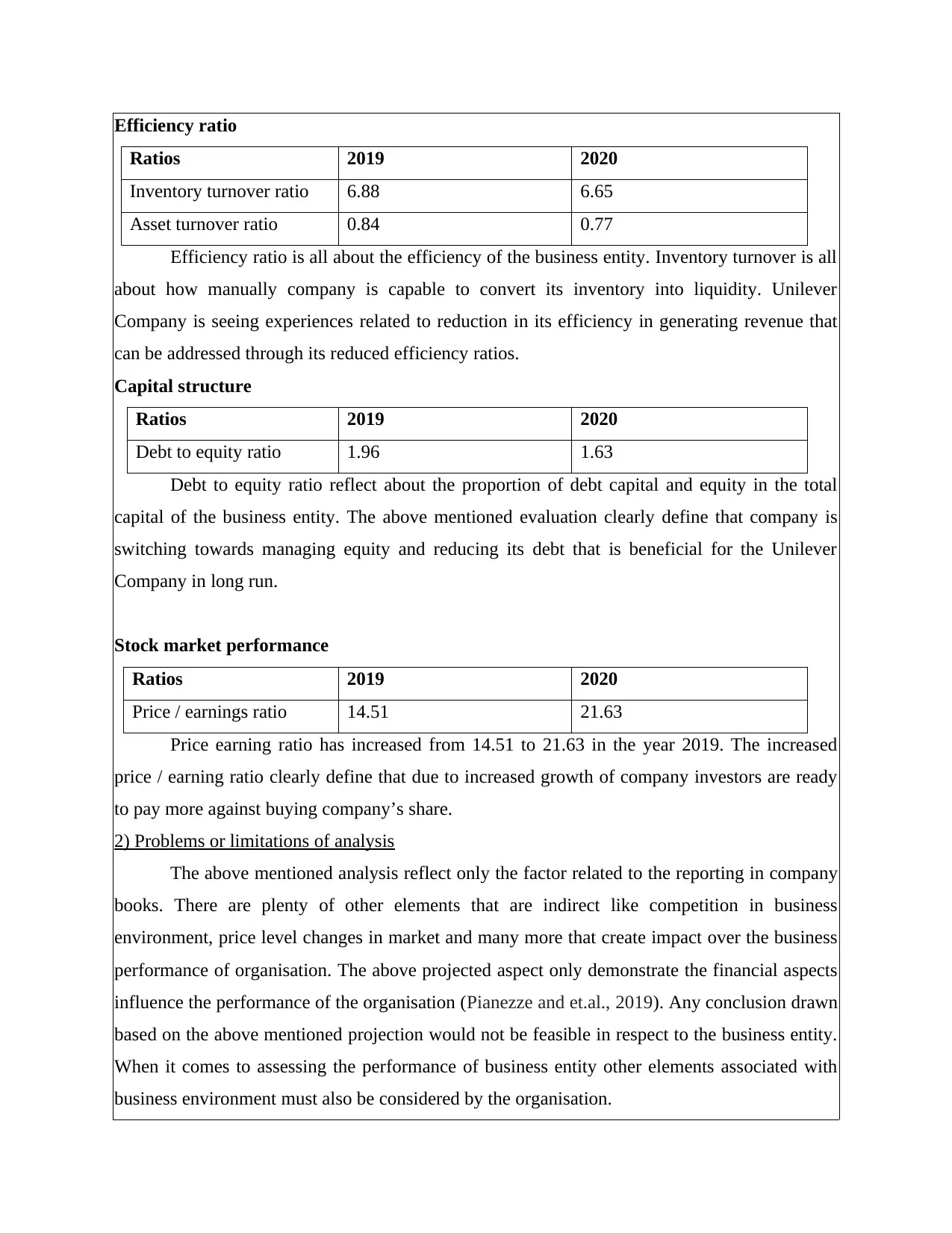
Efficiency ratio
Ratios 2019 2020
Inventory turnover ratio 6.88 6.65
Asset turnover ratio 0.84 0.77
Efficiency ratio is all about the efficiency of the business entity. Inventory turnover is all
about how manually company is capable to convert its inventory into liquidity. Unilever
Company is seeing experiences related to reduction in its efficiency in generating revenue that
can be addressed through its reduced efficiency ratios.
Capital structure
Ratios 2019 2020
Debt to equity ratio 1.96 1.63
Debt to equity ratio reflect about the proportion of debt capital and equity in the total
capital of the business entity. The above mentioned evaluation clearly define that company is
switching towards managing equity and reducing its debt that is beneficial for the Unilever
Company in long run.
Stock market performance
Ratios 2019 2020
Price / earnings ratio 14.51 21.63
Price earning ratio has increased from 14.51 to 21.63 in the year 2019. The increased
price / earning ratio clearly define that due to increased growth of company investors are ready
to pay more against buying company’s share.
2) Problems or limitations of analysis
The above mentioned analysis reflect only the factor related to the reporting in company
books. There are plenty of other elements that are indirect like competition in business
environment, price level changes in market and many more that create impact over the business
performance of organisation. The above projected aspect only demonstrate the financial aspects
influence the performance of the organisation (Pianezze and et.al., 2019). Any conclusion drawn
based on the above mentioned projection would not be feasible in respect to the business entity.
When it comes to assessing the performance of business entity other elements associated with
business environment must also be considered by the organisation.
Ratios 2019 2020
Inventory turnover ratio 6.88 6.65
Asset turnover ratio 0.84 0.77
Efficiency ratio is all about the efficiency of the business entity. Inventory turnover is all
about how manually company is capable to convert its inventory into liquidity. Unilever
Company is seeing experiences related to reduction in its efficiency in generating revenue that
can be addressed through its reduced efficiency ratios.
Capital structure
Ratios 2019 2020
Debt to equity ratio 1.96 1.63
Debt to equity ratio reflect about the proportion of debt capital and equity in the total
capital of the business entity. The above mentioned evaluation clearly define that company is
switching towards managing equity and reducing its debt that is beneficial for the Unilever
Company in long run.
Stock market performance
Ratios 2019 2020
Price / earnings ratio 14.51 21.63
Price earning ratio has increased from 14.51 to 21.63 in the year 2019. The increased
price / earning ratio clearly define that due to increased growth of company investors are ready
to pay more against buying company’s share.
2) Problems or limitations of analysis
The above mentioned analysis reflect only the factor related to the reporting in company
books. There are plenty of other elements that are indirect like competition in business
environment, price level changes in market and many more that create impact over the business
performance of organisation. The above projected aspect only demonstrate the financial aspects
influence the performance of the organisation (Pianezze and et.al., 2019). Any conclusion drawn
based on the above mentioned projection would not be feasible in respect to the business entity.
When it comes to assessing the performance of business entity other elements associated with
business environment must also be considered by the organisation.
Paraphrase This Document
Need a fresh take? Get an instant paraphrase of this document with our AI Paraphraser
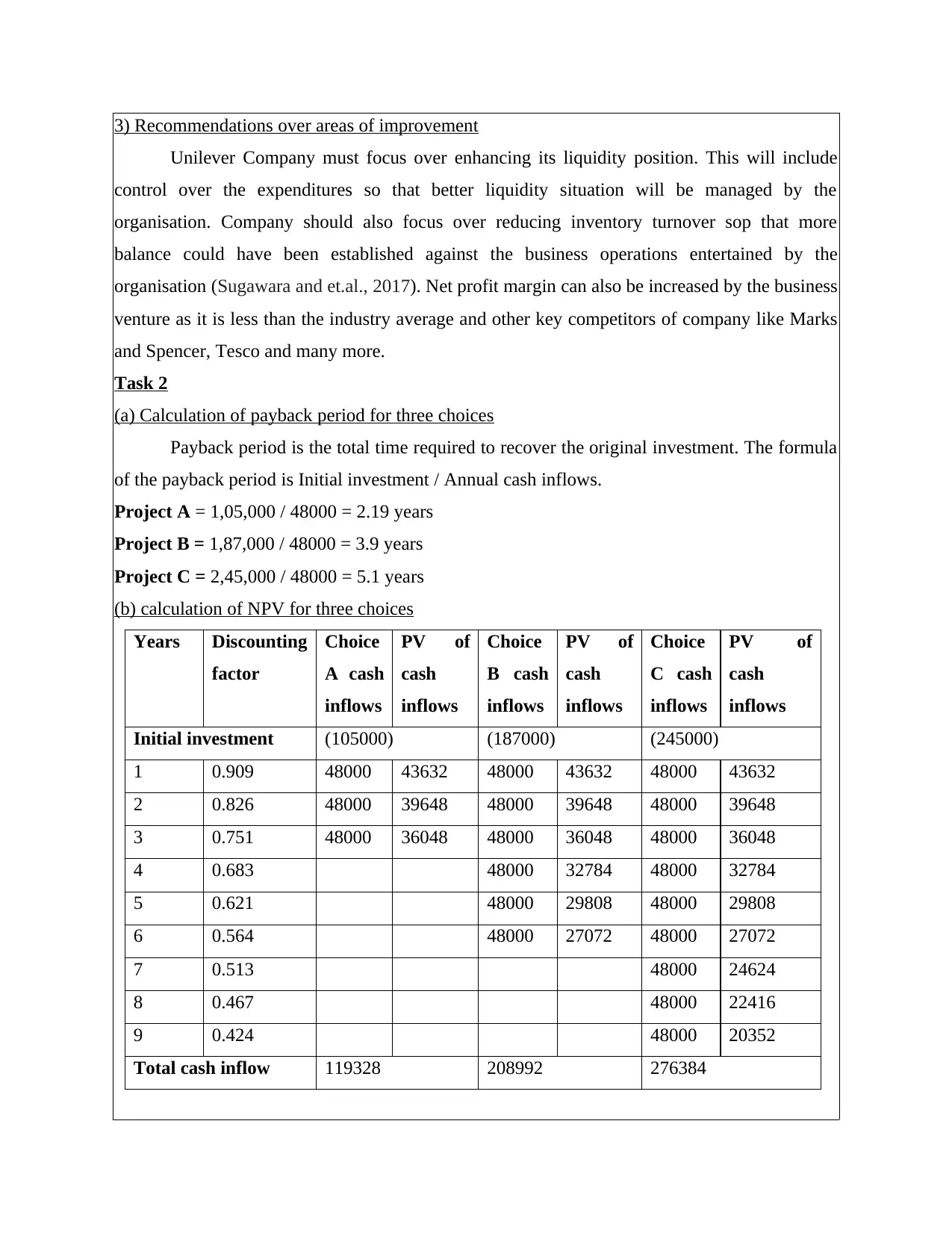
3) Recommendations over areas of improvement
Unilever Company must focus over enhancing its liquidity position. This will include
control over the expenditures so that better liquidity situation will be managed by the
organisation. Company should also focus over reducing inventory turnover sop that more
balance could have been established against the business operations entertained by the
organisation (Sugawara and et.al., 2017). Net profit margin can also be increased by the business
venture as it is less than the industry average and other key competitors of company like Marks
and Spencer, Tesco and many more.
Task 2
(a) Calculation of payback period for three choices
Payback period is the total time required to recover the original investment. The formula
of the payback period is Initial investment / Annual cash inflows.
Project A = 1,05,000 / 48000 = 2.19 years
Project B = 1,87,000 / 48000 = 3.9 years
Project C = 2,45,000 / 48000 = 5.1 years
(b) calculation of NPV for three choices
Years Discounting
factor
Choice
A cash
inflows
PV of
cash
inflows
Choice
B cash
inflows
PV of
cash
inflows
Choice
C cash
inflows
PV of
cash
inflows
Initial investment (105000) (187000) (245000)
1 0.909 48000 43632 48000 43632 48000 43632
2 0.826 48000 39648 48000 39648 48000 39648
3 0.751 48000 36048 48000 36048 48000 36048
4 0.683 48000 32784 48000 32784
5 0.621 48000 29808 48000 29808
6 0.564 48000 27072 48000 27072
7 0.513 48000 24624
8 0.467 48000 22416
9 0.424 48000 20352
Total cash inflow 119328 208992 276384
Unilever Company must focus over enhancing its liquidity position. This will include
control over the expenditures so that better liquidity situation will be managed by the
organisation. Company should also focus over reducing inventory turnover sop that more
balance could have been established against the business operations entertained by the
organisation (Sugawara and et.al., 2017). Net profit margin can also be increased by the business
venture as it is less than the industry average and other key competitors of company like Marks
and Spencer, Tesco and many more.
Task 2
(a) Calculation of payback period for three choices
Payback period is the total time required to recover the original investment. The formula
of the payback period is Initial investment / Annual cash inflows.
Project A = 1,05,000 / 48000 = 2.19 years
Project B = 1,87,000 / 48000 = 3.9 years
Project C = 2,45,000 / 48000 = 5.1 years
(b) calculation of NPV for three choices
Years Discounting
factor
Choice
A cash
inflows
PV of
cash
inflows
Choice
B cash
inflows
PV of
cash
inflows
Choice
C cash
inflows
PV of
cash
inflows
Initial investment (105000) (187000) (245000)
1 0.909 48000 43632 48000 43632 48000 43632
2 0.826 48000 39648 48000 39648 48000 39648
3 0.751 48000 36048 48000 36048 48000 36048
4 0.683 48000 32784 48000 32784
5 0.621 48000 29808 48000 29808
6 0.564 48000 27072 48000 27072
7 0.513 48000 24624
8 0.467 48000 22416
9 0.424 48000 20352
Total cash inflow 119328 208992 276384
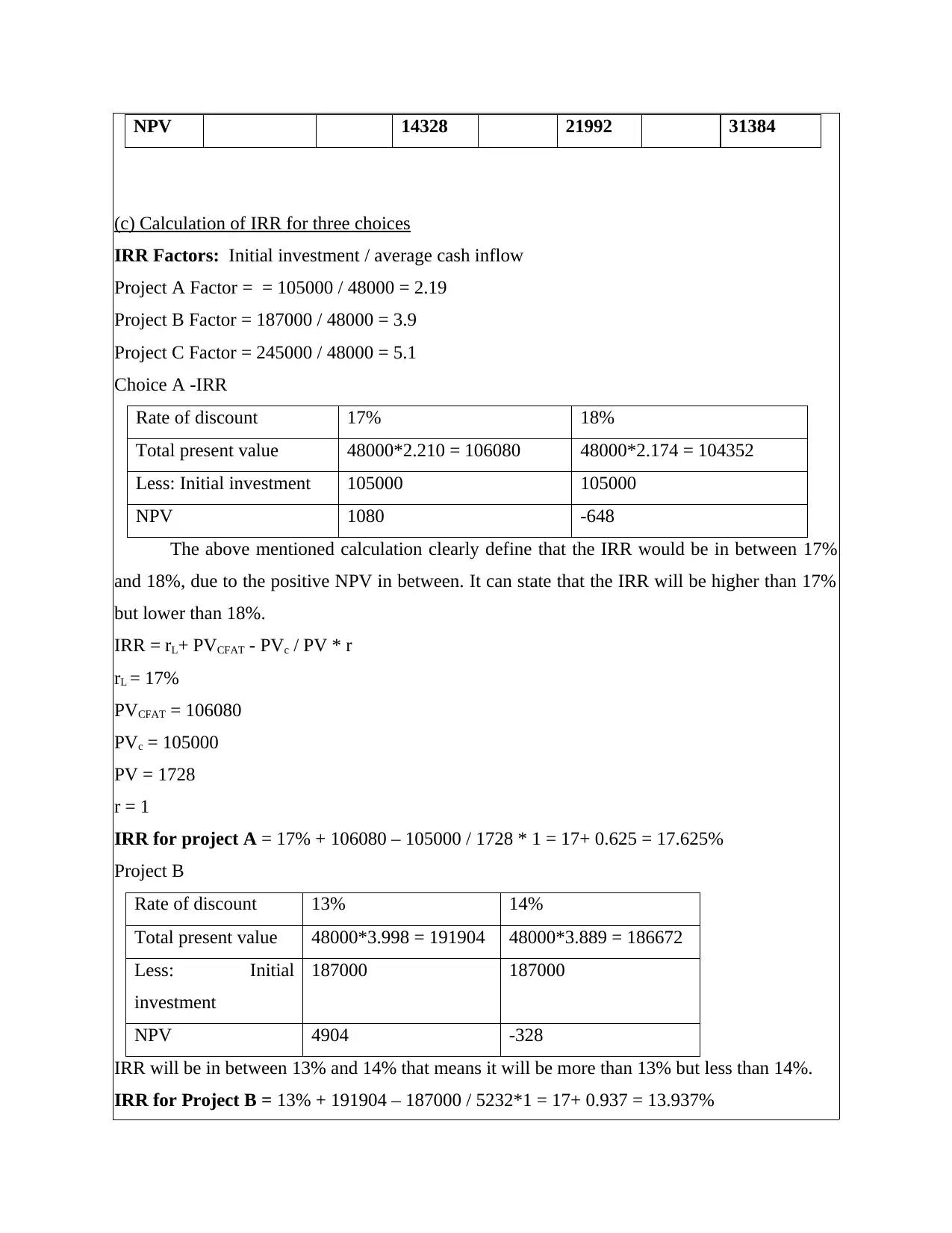
NPV 14328 21992 31384
(c) Calculation of IRR for three choices
IRR Factors: Initial investment / average cash inflow
Project A Factor = = 105000 / 48000 = 2.19
Project B Factor = 187000 / 48000 = 3.9
Project C Factor = 245000 / 48000 = 5.1
Choice A -IRR
Rate of discount 17% 18%
Total present value 48000*2.210 = 106080 48000*2.174 = 104352
Less: Initial investment 105000 105000
NPV 1080 -648
The above mentioned calculation clearly define that the IRR would be in between 17%
and 18%, due to the positive NPV in between. It can state that the IRR will be higher than 17%
but lower than 18%.
IRR = rL+ PVCFAT - PVc / PV * r
rL = 17%
PVCFAT = 106080
PVc = 105000
PV = 1728
r = 1
IRR for project A = 17% + 106080 – 105000 / 1728 * 1 = 17+ 0.625 = 17.625%
Project B
Rate of discount 13% 14%
Total present value 48000*3.998 = 191904 48000*3.889 = 186672
Less: Initial
investment
187000 187000
NPV 4904 -328
IRR will be in between 13% and 14% that means it will be more than 13% but less than 14%.
IRR for Project B = 13% + 191904 – 187000 / 5232*1 = 17+ 0.937 = 13.937%
(c) Calculation of IRR for three choices
IRR Factors: Initial investment / average cash inflow
Project A Factor = = 105000 / 48000 = 2.19
Project B Factor = 187000 / 48000 = 3.9
Project C Factor = 245000 / 48000 = 5.1
Choice A -IRR
Rate of discount 17% 18%
Total present value 48000*2.210 = 106080 48000*2.174 = 104352
Less: Initial investment 105000 105000
NPV 1080 -648
The above mentioned calculation clearly define that the IRR would be in between 17%
and 18%, due to the positive NPV in between. It can state that the IRR will be higher than 17%
but lower than 18%.
IRR = rL+ PVCFAT - PVc / PV * r
rL = 17%
PVCFAT = 106080
PVc = 105000
PV = 1728
r = 1
IRR for project A = 17% + 106080 – 105000 / 1728 * 1 = 17+ 0.625 = 17.625%
Project B
Rate of discount 13% 14%
Total present value 48000*3.998 = 191904 48000*3.889 = 186672
Less: Initial
investment
187000 187000
NPV 4904 -328
IRR will be in between 13% and 14% that means it will be more than 13% but less than 14%.
IRR for Project B = 13% + 191904 – 187000 / 5232*1 = 17+ 0.937 = 13.937%
⊘ This is a preview!⊘
Do you want full access?
Subscribe today to unlock all pages.

Trusted by 1+ million students worldwide
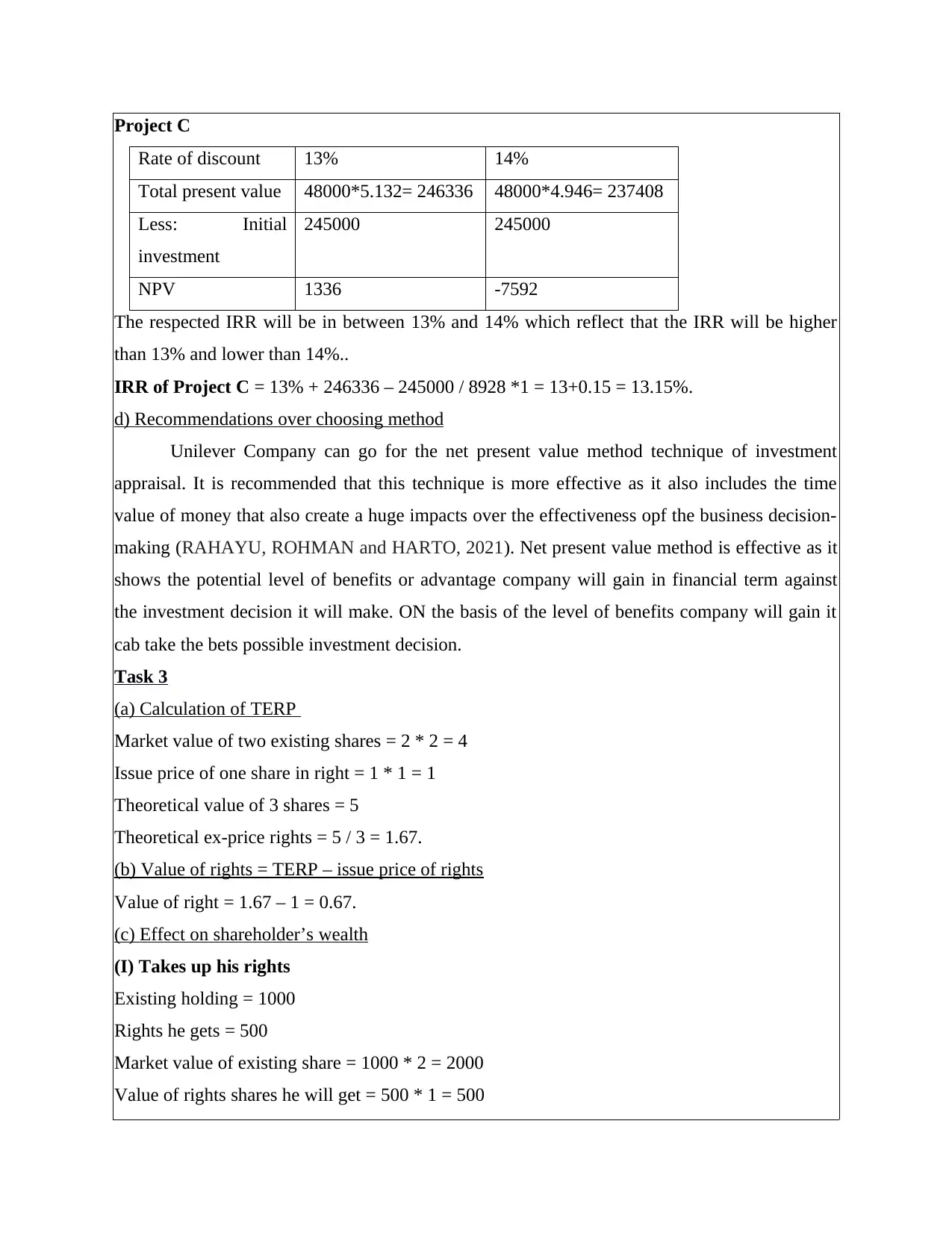
Project C
Rate of discount 13% 14%
Total present value 48000*5.132= 246336 48000*4.946= 237408
Less: Initial
investment
245000 245000
NPV 1336 -7592
The respected IRR will be in between 13% and 14% which reflect that the IRR will be higher
than 13% and lower than 14%..
IRR of Project C = 13% + 246336 – 245000 / 8928 *1 = 13+0.15 = 13.15%.
d) Recommendations over choosing method
Unilever Company can go for the net present value method technique of investment
appraisal. It is recommended that this technique is more effective as it also includes the time
value of money that also create a huge impacts over the effectiveness opf the business decision-
making (RAHAYU, ROHMAN and HARTO, 2021). Net present value method is effective as it
shows the potential level of benefits or advantage company will gain in financial term against
the investment decision it will make. ON the basis of the level of benefits company will gain it
cab take the bets possible investment decision.
Task 3
(a) Calculation of TERP
Market value of two existing shares = 2 * 2 = 4
Issue price of one share in right = 1 * 1 = 1
Theoretical value of 3 shares = 5
Theoretical ex-price rights = 5 / 3 = 1.67.
(b) Value of rights = TERP – issue price of rights
Value of right = 1.67 – 1 = 0.67.
(c) Effect on shareholder’s wealth
(I) Takes up his rights
Existing holding = 1000
Rights he gets = 500
Market value of existing share = 1000 * 2 = 2000
Value of rights shares he will get = 500 * 1 = 500
Rate of discount 13% 14%
Total present value 48000*5.132= 246336 48000*4.946= 237408
Less: Initial
investment
245000 245000
NPV 1336 -7592
The respected IRR will be in between 13% and 14% which reflect that the IRR will be higher
than 13% and lower than 14%..
IRR of Project C = 13% + 246336 – 245000 / 8928 *1 = 13+0.15 = 13.15%.
d) Recommendations over choosing method
Unilever Company can go for the net present value method technique of investment
appraisal. It is recommended that this technique is more effective as it also includes the time
value of money that also create a huge impacts over the effectiveness opf the business decision-
making (RAHAYU, ROHMAN and HARTO, 2021). Net present value method is effective as it
shows the potential level of benefits or advantage company will gain in financial term against
the investment decision it will make. ON the basis of the level of benefits company will gain it
cab take the bets possible investment decision.
Task 3
(a) Calculation of TERP
Market value of two existing shares = 2 * 2 = 4
Issue price of one share in right = 1 * 1 = 1
Theoretical value of 3 shares = 5
Theoretical ex-price rights = 5 / 3 = 1.67.
(b) Value of rights = TERP – issue price of rights
Value of right = 1.67 – 1 = 0.67.
(c) Effect on shareholder’s wealth
(I) Takes up his rights
Existing holding = 1000
Rights he gets = 500
Market value of existing share = 1000 * 2 = 2000
Value of rights shares he will get = 500 * 1 = 500
Paraphrase This Document
Need a fresh take? Get an instant paraphrase of this document with our AI Paraphraser
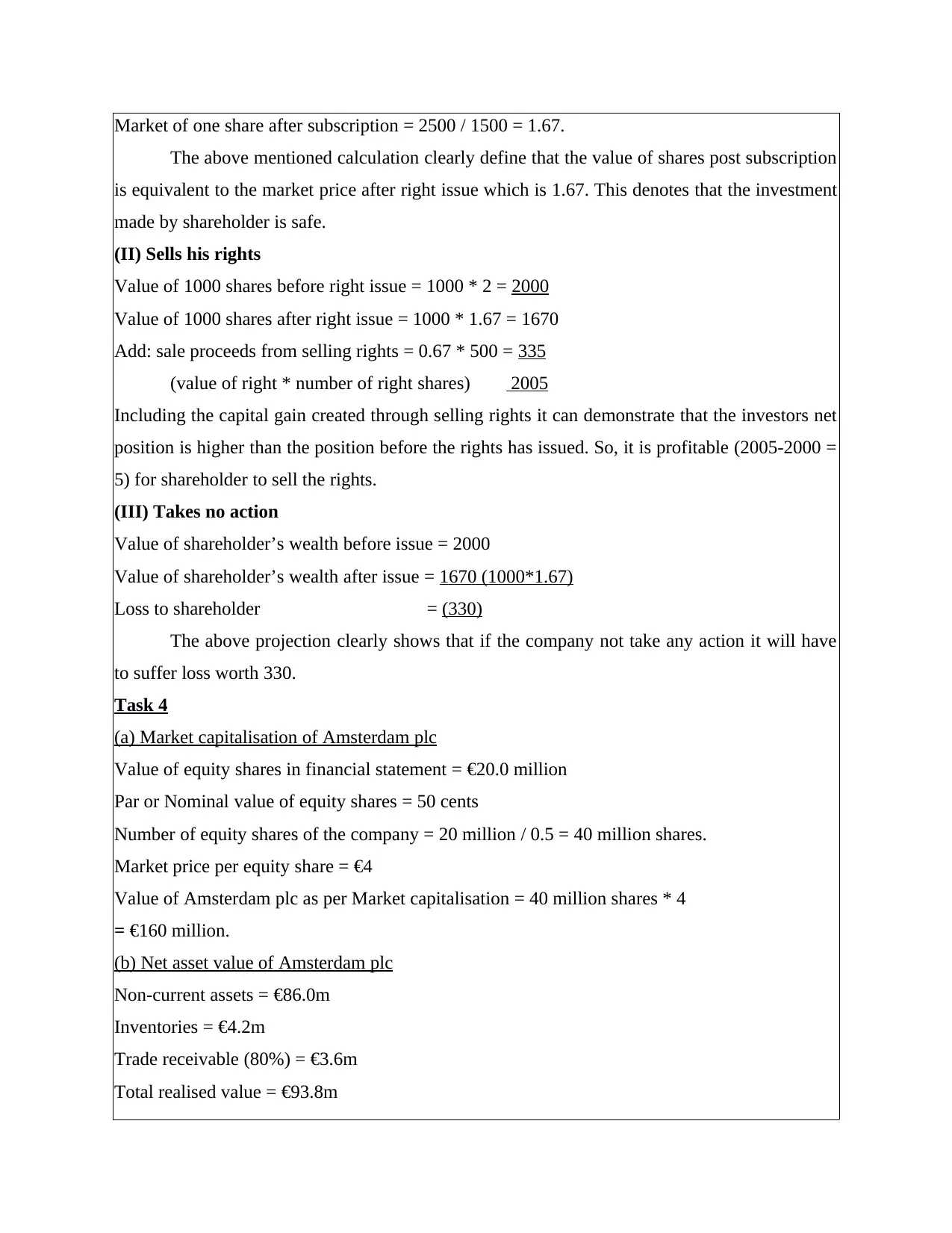
Market of one share after subscription = 2500 / 1500 = 1.67.
The above mentioned calculation clearly define that the value of shares post subscription
is equivalent to the market price after right issue which is 1.67. This denotes that the investment
made by shareholder is safe.
(II) Sells his rights
Value of 1000 shares before right issue = 1000 * 2 = 2000
Value of 1000 shares after right issue = 1000 * 1.67 = 1670
Add: sale proceeds from selling rights = 0.67 * 500 = 335
(value of right * number of right shares) 2005
Including the capital gain created through selling rights it can demonstrate that the investors net
position is higher than the position before the rights has issued. So, it is profitable (2005-2000 =
5) for shareholder to sell the rights.
(III) Takes no action
Value of shareholder’s wealth before issue = 2000
Value of shareholder’s wealth after issue = 1670 (1000*1.67)
Loss to shareholder = (330)
The above projection clearly shows that if the company not take any action it will have
to suffer loss worth 330.
Task 4
(a) Market capitalisation of Amsterdam plc
Value of equity shares in financial statement = €20.0 million
Par or Nominal value of equity shares = 50 cents
Number of equity shares of the company = 20 million / 0.5 = 40 million shares.
Market price per equity share = €4
Value of Amsterdam plc as per Market capitalisation = 40 million shares * 4
= €160 million.
(b) Net asset value of Amsterdam plc
Non-current assets = €86.0m
Inventories = €4.2m
Trade receivable (80%) = €3.6m
Total realised value = €93.8m
The above mentioned calculation clearly define that the value of shares post subscription
is equivalent to the market price after right issue which is 1.67. This denotes that the investment
made by shareholder is safe.
(II) Sells his rights
Value of 1000 shares before right issue = 1000 * 2 = 2000
Value of 1000 shares after right issue = 1000 * 1.67 = 1670
Add: sale proceeds from selling rights = 0.67 * 500 = 335
(value of right * number of right shares) 2005
Including the capital gain created through selling rights it can demonstrate that the investors net
position is higher than the position before the rights has issued. So, it is profitable (2005-2000 =
5) for shareholder to sell the rights.
(III) Takes no action
Value of shareholder’s wealth before issue = 2000
Value of shareholder’s wealth after issue = 1670 (1000*1.67)
Loss to shareholder = (330)
The above projection clearly shows that if the company not take any action it will have
to suffer loss worth 330.
Task 4
(a) Market capitalisation of Amsterdam plc
Value of equity shares in financial statement = €20.0 million
Par or Nominal value of equity shares = 50 cents
Number of equity shares of the company = 20 million / 0.5 = 40 million shares.
Market price per equity share = €4
Value of Amsterdam plc as per Market capitalisation = 40 million shares * 4
= €160 million.
(b) Net asset value of Amsterdam plc
Non-current assets = €86.0m
Inventories = €4.2m
Trade receivable (80%) = €3.6m
Total realised value = €93.8m
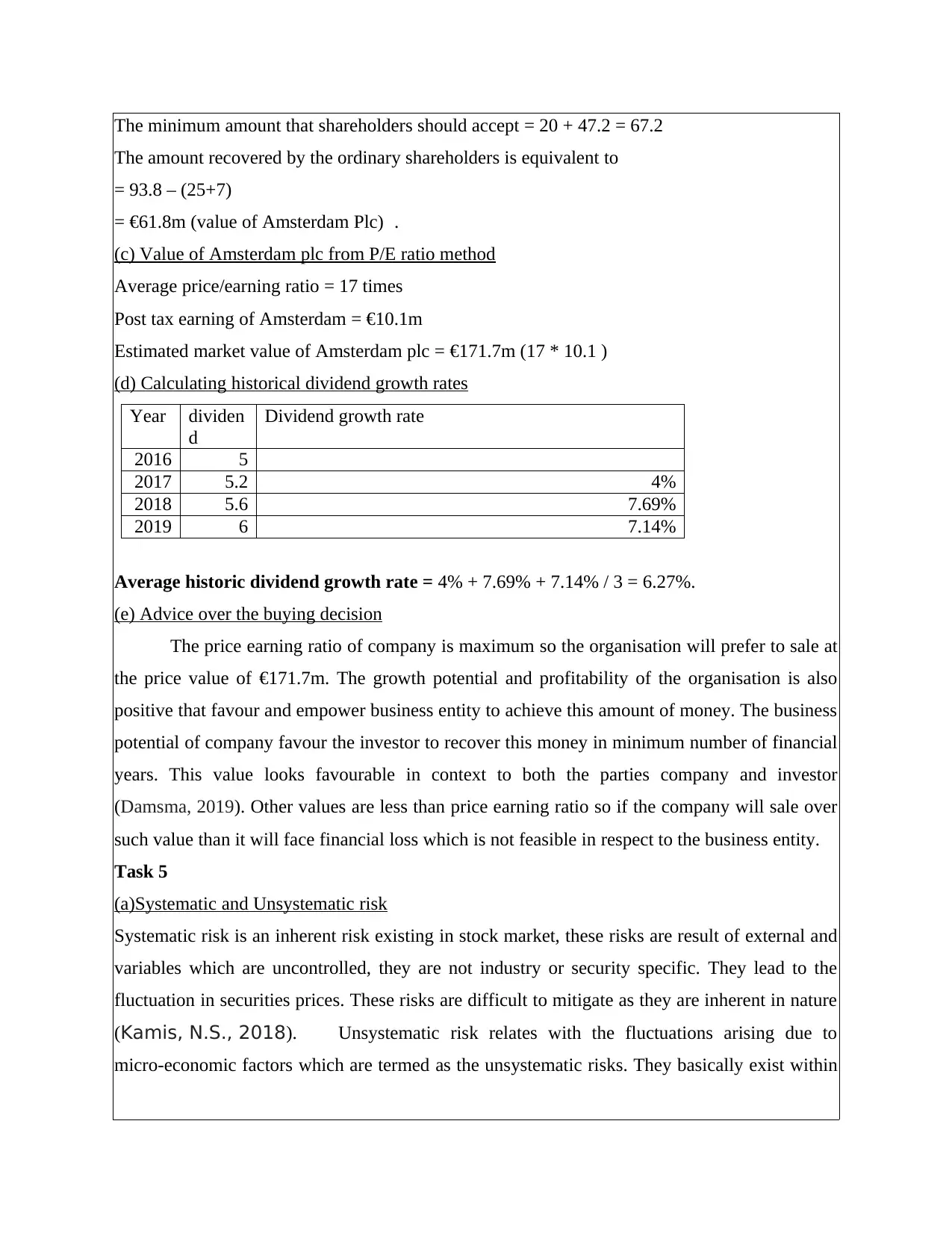
The minimum amount that shareholders should accept = 20 + 47.2 = 67.2
The amount recovered by the ordinary shareholders is equivalent to
= 93.8 – (25+7)
= €61.8m (value of Amsterdam Plc) .
(c) Value of Amsterdam plc from P/E ratio method
Average price/earning ratio = 17 times
Post tax earning of Amsterdam = €10.1m
Estimated market value of Amsterdam plc = €171.7m (17 * 10.1 )
(d) Calculating historical dividend growth rates
Year dividen
d
Dividend growth rate
2016 5
2017 5.2 4%
2018 5.6 7.69%
2019 6 7.14%
Average historic dividend growth rate = 4% + 7.69% + 7.14% / 3 = 6.27%.
(e) Advice over the buying decision
The price earning ratio of company is maximum so the organisation will prefer to sale at
the price value of €171.7m. The growth potential and profitability of the organisation is also
positive that favour and empower business entity to achieve this amount of money. The business
potential of company favour the investor to recover this money in minimum number of financial
years. This value looks favourable in context to both the parties company and investor
(Damsma, 2019). Other values are less than price earning ratio so if the company will sale over
such value than it will face financial loss which is not feasible in respect to the business entity.
Task 5
(a)Systematic and Unsystematic risk
Systematic risk is an inherent risk existing in stock market, these risks are result of external and
variables which are uncontrolled, they are not industry or security specific. They lead to the
fluctuation in securities prices. These risks are difficult to mitigate as they are inherent in nature
(Kamis, N.S., 2018). Unsystematic risk relates with the fluctuations arising due to
micro-economic factors which are termed as the unsystematic risks. They basically exist within
The amount recovered by the ordinary shareholders is equivalent to
= 93.8 – (25+7)
= €61.8m (value of Amsterdam Plc) .
(c) Value of Amsterdam plc from P/E ratio method
Average price/earning ratio = 17 times
Post tax earning of Amsterdam = €10.1m
Estimated market value of Amsterdam plc = €171.7m (17 * 10.1 )
(d) Calculating historical dividend growth rates
Year dividen
d
Dividend growth rate
2016 5
2017 5.2 4%
2018 5.6 7.69%
2019 6 7.14%
Average historic dividend growth rate = 4% + 7.69% + 7.14% / 3 = 6.27%.
(e) Advice over the buying decision
The price earning ratio of company is maximum so the organisation will prefer to sale at
the price value of €171.7m. The growth potential and profitability of the organisation is also
positive that favour and empower business entity to achieve this amount of money. The business
potential of company favour the investor to recover this money in minimum number of financial
years. This value looks favourable in context to both the parties company and investor
(Damsma, 2019). Other values are less than price earning ratio so if the company will sale over
such value than it will face financial loss which is not feasible in respect to the business entity.
Task 5
(a)Systematic and Unsystematic risk
Systematic risk is an inherent risk existing in stock market, these risks are result of external and
variables which are uncontrolled, they are not industry or security specific. They lead to the
fluctuation in securities prices. These risks are difficult to mitigate as they are inherent in nature
(Kamis, N.S., 2018). Unsystematic risk relates with the fluctuations arising due to
micro-economic factors which are termed as the unsystematic risks. They basically exist within
⊘ This is a preview!⊘
Do you want full access?
Subscribe today to unlock all pages.

Trusted by 1+ million students worldwide
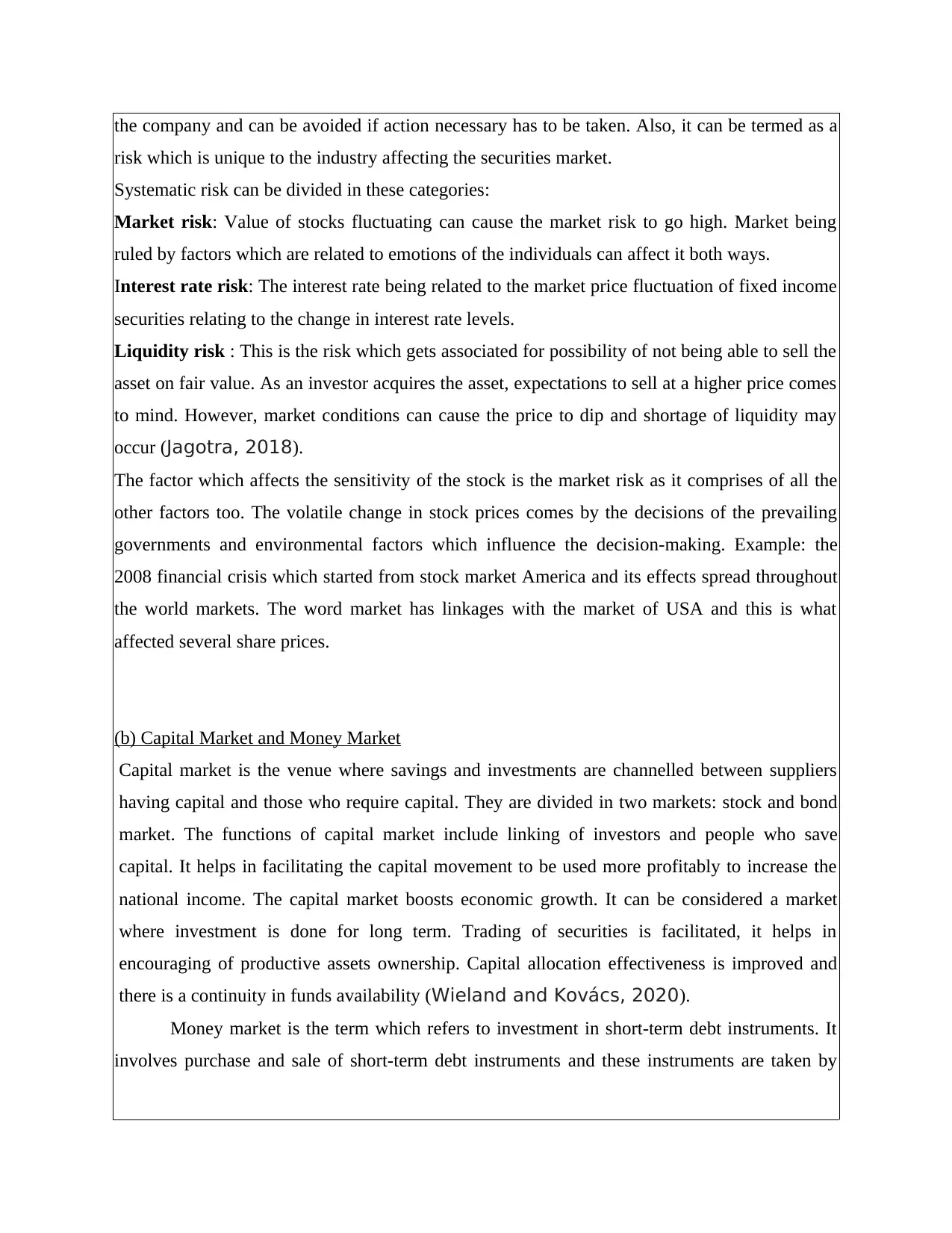
the company and can be avoided if action necessary has to be taken. Also, it can be termed as a
risk which is unique to the industry affecting the securities market.
Systematic risk can be divided in these categories:
Market risk: Value of stocks fluctuating can cause the market risk to go high. Market being
ruled by factors which are related to emotions of the individuals can affect it both ways.
Interest rate risk: The interest rate being related to the market price fluctuation of fixed income
securities relating to the change in interest rate levels.
Liquidity risk : This is the risk which gets associated for possibility of not being able to sell the
asset on fair value. As an investor acquires the asset, expectations to sell at a higher price comes
to mind. However, market conditions can cause the price to dip and shortage of liquidity may
occur (Jagotra, 2018).
The factor which affects the sensitivity of the stock is the market risk as it comprises of all the
other factors too. The volatile change in stock prices comes by the decisions of the prevailing
governments and environmental factors which influence the decision-making. Example: the
2008 financial crisis which started from stock market America and its effects spread throughout
the world markets. The word market has linkages with the market of USA and this is what
affected several share prices.
(b) Capital Market and Money Market
Capital market is the venue where savings and investments are channelled between suppliers
having capital and those who require capital. They are divided in two markets: stock and bond
market. The functions of capital market include linking of investors and people who save
capital. It helps in facilitating the capital movement to be used more profitably to increase the
national income. The capital market boosts economic growth. It can be considered a market
where investment is done for long term. Trading of securities is facilitated, it helps in
encouraging of productive assets ownership. Capital allocation effectiveness is improved and
there is a continuity in funds availability (Wieland and Kovács, 2020).
Money market is the term which refers to investment in short-term debt instruments. It
involves purchase and sale of short-term debt instruments and these instruments are taken by
risk which is unique to the industry affecting the securities market.
Systematic risk can be divided in these categories:
Market risk: Value of stocks fluctuating can cause the market risk to go high. Market being
ruled by factors which are related to emotions of the individuals can affect it both ways.
Interest rate risk: The interest rate being related to the market price fluctuation of fixed income
securities relating to the change in interest rate levels.
Liquidity risk : This is the risk which gets associated for possibility of not being able to sell the
asset on fair value. As an investor acquires the asset, expectations to sell at a higher price comes
to mind. However, market conditions can cause the price to dip and shortage of liquidity may
occur (Jagotra, 2018).
The factor which affects the sensitivity of the stock is the market risk as it comprises of all the
other factors too. The volatile change in stock prices comes by the decisions of the prevailing
governments and environmental factors which influence the decision-making. Example: the
2008 financial crisis which started from stock market America and its effects spread throughout
the world markets. The word market has linkages with the market of USA and this is what
affected several share prices.
(b) Capital Market and Money Market
Capital market is the venue where savings and investments are channelled between suppliers
having capital and those who require capital. They are divided in two markets: stock and bond
market. The functions of capital market include linking of investors and people who save
capital. It helps in facilitating the capital movement to be used more profitably to increase the
national income. The capital market boosts economic growth. It can be considered a market
where investment is done for long term. Trading of securities is facilitated, it helps in
encouraging of productive assets ownership. Capital allocation effectiveness is improved and
there is a continuity in funds availability (Wieland and Kovács, 2020).
Money market is the term which refers to investment in short-term debt instruments. It
involves purchase and sale of short-term debt instruments and these instruments are taken by
Paraphrase This Document
Need a fresh take? Get an instant paraphrase of this document with our AI Paraphraser
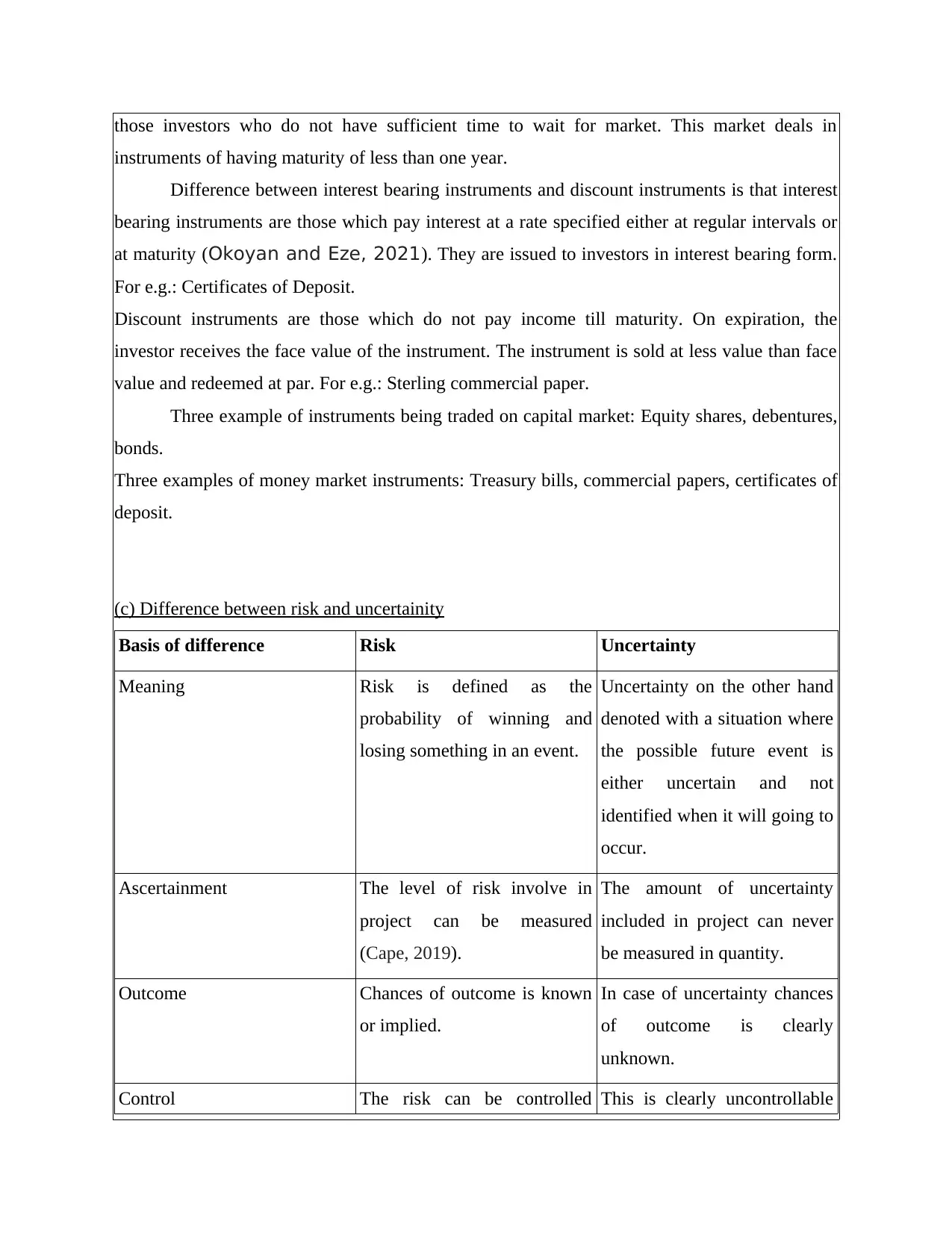
those investors who do not have sufficient time to wait for market. This market deals in
instruments of having maturity of less than one year.
Difference between interest bearing instruments and discount instruments is that interest
bearing instruments are those which pay interest at a rate specified either at regular intervals or
at maturity (Okoyan and Eze, 2021). They are issued to investors in interest bearing form.
For e.g.: Certificates of Deposit.
Discount instruments are those which do not pay income till maturity. On expiration, the
investor receives the face value of the instrument. The instrument is sold at less value than face
value and redeemed at par. For e.g.: Sterling commercial paper.
Three example of instruments being traded on capital market: Equity shares, debentures,
bonds.
Three examples of money market instruments: Treasury bills, commercial papers, certificates of
deposit.
(c) Difference between risk and uncertainity
Basis of difference Risk Uncertainty
Meaning Risk is defined as the
probability of winning and
losing something in an event.
Uncertainty on the other hand
denoted with a situation where
the possible future event is
either uncertain and not
identified when it will going to
occur.
Ascertainment The level of risk involve in
project can be measured
(Cape, 2019).
The amount of uncertainty
included in project can never
be measured in quantity.
Outcome Chances of outcome is known
or implied.
In case of uncertainty chances
of outcome is clearly
unknown.
Control The risk can be controlled This is clearly uncontrollable
instruments of having maturity of less than one year.
Difference between interest bearing instruments and discount instruments is that interest
bearing instruments are those which pay interest at a rate specified either at regular intervals or
at maturity (Okoyan and Eze, 2021). They are issued to investors in interest bearing form.
For e.g.: Certificates of Deposit.
Discount instruments are those which do not pay income till maturity. On expiration, the
investor receives the face value of the instrument. The instrument is sold at less value than face
value and redeemed at par. For e.g.: Sterling commercial paper.
Three example of instruments being traded on capital market: Equity shares, debentures,
bonds.
Three examples of money market instruments: Treasury bills, commercial papers, certificates of
deposit.
(c) Difference between risk and uncertainity
Basis of difference Risk Uncertainty
Meaning Risk is defined as the
probability of winning and
losing something in an event.
Uncertainty on the other hand
denoted with a situation where
the possible future event is
either uncertain and not
identified when it will going to
occur.
Ascertainment The level of risk involve in
project can be measured
(Cape, 2019).
The amount of uncertainty
included in project can never
be measured in quantity.
Outcome Chances of outcome is known
or implied.
In case of uncertainty chances
of outcome is clearly
unknown.
Control The risk can be controlled This is clearly uncontrollable
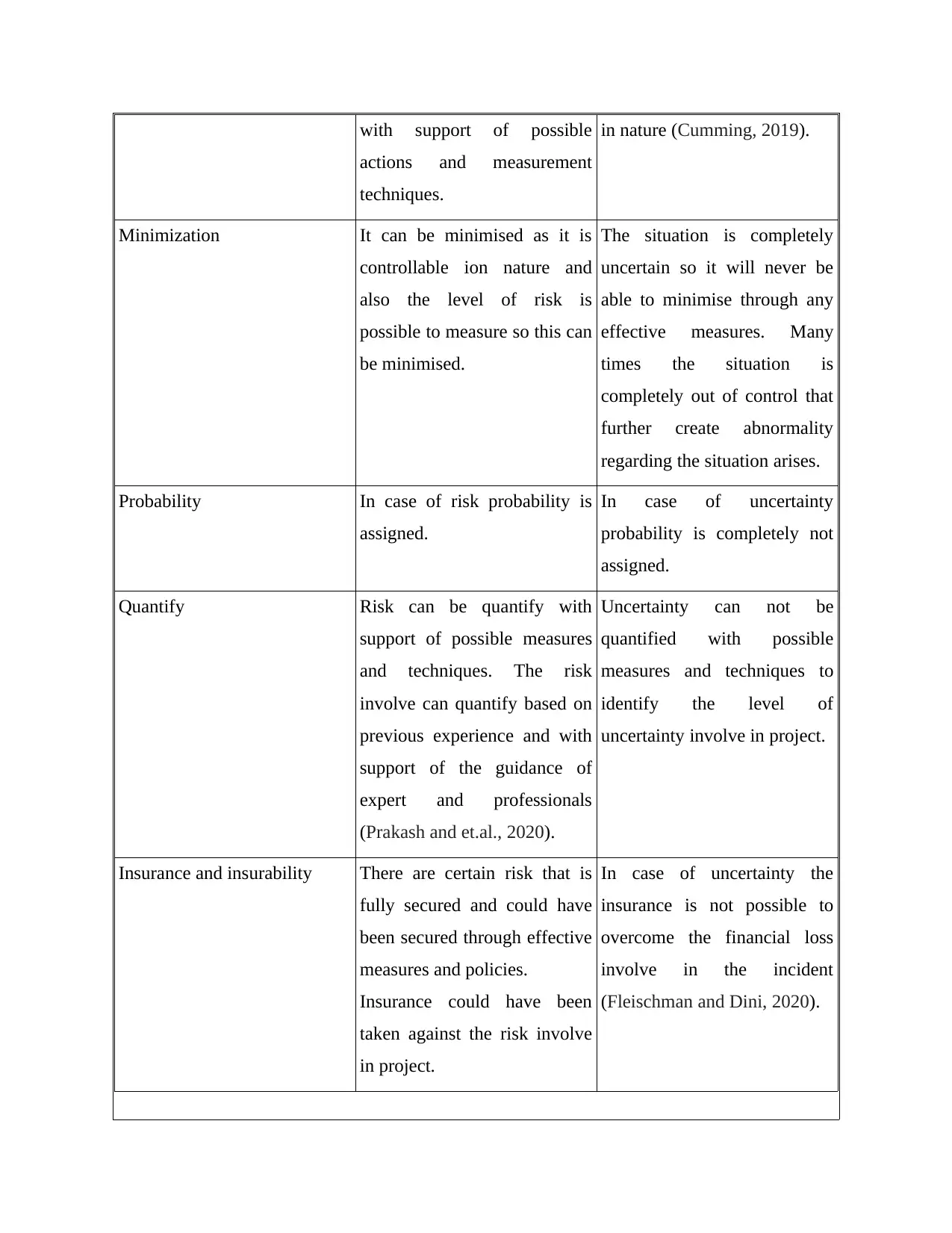
with support of possible
actions and measurement
techniques.
in nature (Cumming, 2019).
Minimization It can be minimised as it is
controllable ion nature and
also the level of risk is
possible to measure so this can
be minimised.
The situation is completely
uncertain so it will never be
able to minimise through any
effective measures. Many
times the situation is
completely out of control that
further create abnormality
regarding the situation arises.
Probability In case of risk probability is
assigned.
In case of uncertainty
probability is completely not
assigned.
Quantify Risk can be quantify with
support of possible measures
and techniques. The risk
involve can quantify based on
previous experience and with
support of the guidance of
expert and professionals
(Prakash and et.al., 2020).
Uncertainty can not be
quantified with possible
measures and techniques to
identify the level of
uncertainty involve in project.
Insurance and insurability There are certain risk that is
fully secured and could have
been secured through effective
measures and policies.
Insurance could have been
taken against the risk involve
in project.
In case of uncertainty the
insurance is not possible to
overcome the financial loss
involve in the incident
(Fleischman and Dini, 2020).
actions and measurement
techniques.
in nature (Cumming, 2019).
Minimization It can be minimised as it is
controllable ion nature and
also the level of risk is
possible to measure so this can
be minimised.
The situation is completely
uncertain so it will never be
able to minimise through any
effective measures. Many
times the situation is
completely out of control that
further create abnormality
regarding the situation arises.
Probability In case of risk probability is
assigned.
In case of uncertainty
probability is completely not
assigned.
Quantify Risk can be quantify with
support of possible measures
and techniques. The risk
involve can quantify based on
previous experience and with
support of the guidance of
expert and professionals
(Prakash and et.al., 2020).
Uncertainty can not be
quantified with possible
measures and techniques to
identify the level of
uncertainty involve in project.
Insurance and insurability There are certain risk that is
fully secured and could have
been secured through effective
measures and policies.
Insurance could have been
taken against the risk involve
in project.
In case of uncertainty the
insurance is not possible to
overcome the financial loss
involve in the incident
(Fleischman and Dini, 2020).
⊘ This is a preview!⊘
Do you want full access?
Subscribe today to unlock all pages.

Trusted by 1+ million students worldwide
1 out of 15